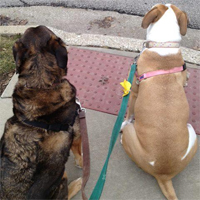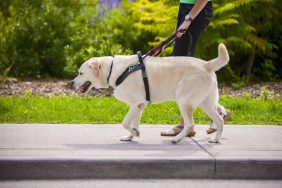The dog world is certainly full of a diverse range of canine personalities. There are shy dogs, hyper dogs, dogs who are in training; there are dogs who don’t like dogs, dogs who are picky about humans, and rescue dogs just beginning their journey to a place of peace and calm; there are senior pets with health issues, young pups in need of manners, and dogs who are just plain antisocial but who still like to take strolls around the block with their people.
Sure, many dogs are perfectly content to be the center of attention at the neighborhood dog park, while others just aren’t made to be social butterflies all the time. But sometimes that doesn’t stop curious people and pets from attempting to greet a nervous pet without asking, and that can lead to devastating consequences.
Sometimes it can be difficult to tell which dogs might be in need of a little breathing room. That’s why Canadian dog trainer Tara Palardy from Innisfall, Alberta, started the Yellow Dog Project, a program she designed to spread the word about dogs in need of space using a special marker she hopes will soon be an internationally understood symbol — a yellow ribbon.
The concept behind the Yellow Dog Project is incredibly simple. By tying a yellow ribbon onto the leash of a dog who would really prefer his or her space, the owner is sending a message to others to that their pooch should not be approached without permission — by humans or their canine companions — and to please maintain distance when passing.
What started off as a small idea has now snowballed into a worldwide movement; as of 2013, the Yellow Dog Project has reached nearly 50 countries and is growing by the day.
Washington D.C. retiree Alice Thurston has decided to try the Yellow Dog Project ribbon concept with her nervous Dachshund, Toby. Toby’s severe phobia of big dogs has made it a challenge for Thurston to take him out for fear he will have a run in with a Saint Bernard, a Mastiff or another large breed dog and react poorly.
“I just get so tired of having to say, ‘You know, my dog is not friendly,’ and to have to go out of my way to avoid other dogs, Thurston tells USA Today. “I’m embarrassed by it.”
A yellow ribbon isn’t necessarily an indication of a dangerous or aggressive animal; rather, it should be interpreted as a caution sign and a request for space, a marker that protects the passersby and keeps the yellow-ribboned dog as free from stress as possible while he or she learns to navigate the hustle and bustle of the outside world.
The Yellow Dog Project has also inspired many service and therapy dog owners to tie yellow ribbons on their dogs leashes and harnesses to let people know their canine companion is on the job and should not be approached by other humans or dogs.
While many trainers, animal behaviorists and owners in-the-know have started using the yellow ribbons on their dogs’ leashes, the signal is not yet widely known; the Yellow Dog Project is urging animal advocates, veterinary offices, training facilities and more to spread the word about the movement. Printable fliers are available on the group’s website.
For more information about the Yellow Dog Project or updates on the movement’s progress, visit the group’s Facebook page.
Sources: USAToday.com, YellowDogProject.com









